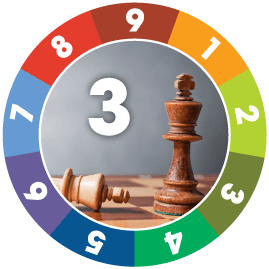
Enneagram Threes are likely to value achievement and want to be the best. As a result, efficiency, results, recognition and image are very important to them. Threes strive for success in their chosen field and tend to be highly flexible and willing to adapt to achieve their goals. At their best, others will experience Threes as hard-working, principled and receptive, offering the gifts of hope and integrity to the world. In an unhealthy state, the Three's over-expressed need for achievement may seem self-important and inconstant. This stems from a sense of self-worth that is built on what the Three does, rather than who they are.
Self-Talk
“The world values winners. I must succeed at all costs. I must avoid failure. I am what I do - to earn my place, I must be the best at what I do.”

As a "doer" and goal-directed type, Threes focus on the task at hand and are energetic in working towards their goals. The adaptive Three is often referred to as the "chameleon" as they change their persona and adapt their role, behaviour, communication and presentation to suit the audience they are trying to impress. The competitiveness of the Three will come to the fore at work and in recreational activities. Some Threes are very drawn to activities that allow for individual competition and achievement, while more social Threes are drawn to winning teams. In a team environment, the Threes may find themselves drawn to leadership roles and others are likely to experience them as very energetic and confident. They dress for success and will make sure that the way they look serves their purpose, ambitions and audience.
Threes are likely to be very adept at framing mistakes and failures as "learning opportunities", allowing them to quickly move on from these failures rather than dwelling on them and taking the setbacks personally. They find it easy to connect to data that supports their point of view, while other information will quickly fade away. As an intellectually calculating individual, the Three's mental energy is focused on their goals and what it takes to achieve them. Their thought processes are likely to be quick, enabling them to adapt to changing situations rapidly. Threes frequently "assess" or read the situation to ensure that they are acting, engaging and communicating in a way that will enhance the chances of success. The Three's competitiveness is linked to their habit of mentally comparing themselves to others, leading to feelings of being better than or worse than others. Threes tend to over-identify with their work, whether that work is corporate, parenting or creative, to the point that what they do defines who they are.
Threes are good at detaching from their emotions, to prevent feelings getting in the way of achievement. They prefer to set emotions aside and will seldom have any time for self-reflection or talking about feelings, especially feelings that relate to anxiety, sadness and fear. While sad and anxious feelings are present in the Three, they find it easier to connect to frustration and anger. Threes are unwilling to risk the good opinion of influential people and so if the people involved are key to success, the Three will struggle to fully connect to these frustrations. A lot of a Three's feeling Center will focus on how other people are reacting to them. Their optimism is projected outwardly, but on the inside Threes may be feeling more distrustful than their positive behaviour reveals to others. Projecting confidence is very important to Threes, who want to look confident and will mask feelings that may detract from this image. Others are therefore likely to experience Threes as unmoved, focused and even somewhat serious. Under continued pressure or when faced with the possibility of failure, Threes are, however, likely to become more short-tempered and snappy.
Click below to explore the Wings
Type 3 Wing 2: Type 3 Wing 4:The Enneagram Three's need for success is defined and expressed differently by the three different Subtypes.




The Integrative Enneagram Questionnaire is a dynamically adaptive intelligent assessment. It will take you about 30 minutes to complete and it will measure: Enneagram Profile, 27 Subtypes, Centers, Wings, Lines, Levels of Integration and 6 dimensions of Strain.
Get Your Type